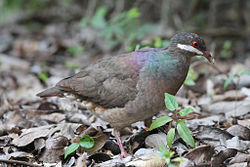| Geotrygon | |
|---|---|
 | |
| Key West quail-dove | |
| Scientific classification | |
| Kingdom: | Animalia |
| Phylum: | Chordata |
| Class: | Aves |
| Order: | Columbiformes |
| Family: | Columbidae |
| Subfamily: | Columbinae |
| Genus: | Geotrygon Gosse, 1847 |
| Type species | |
| Columba cristata [1] = Geotrygon versicolor Temminck, 1809 | |
| Species | |
see text | |
Geotrygon is a bird genus in the pigeon and dove family (Columbidae). Its members are called quail-doves, and all live in the Neotropics. The species of this genus have ranges from southern Mexico and Central America to the West Indies and South America, with 2 species recorded as occasional vagrants reported in Texas and Florida in the United States. Quail-doves are ground-dwelling pigeons that live, nest, and feed in dense forests. They are remarkable for their vivid coloration with light-and-dark facial markings.

















